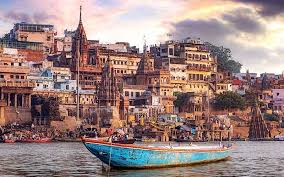CHIKANKARI

Belongs to – Lucknow, Uttar Pradesh
Famous as shadow work, Chikankari embroidery is a very delicate and intricate work from the city of Lucknow. A skill more than 200 years old, the embroidery is famous for its timeless grace and gossamer delicacy. Also known as Chikan, the embroidery is traditionally done using a white untwisted cotton thread on colorless muslin popularly known as tanzeb (the Muslim from Dacca).
This form of embroidery came to India from Persia with Noor Jehan, the queen of the Mughal Emperor Jehangir. It is also said that the word chikan is a derivative from the Persian word ‘chikaan‘ meaning drapery. The craft flourished under the benign nawabi influence and later with the British influence designs became more formal resulting in an export market in Europe and England.
Material
Originally, chikan embroidery was done with the untwisted white cotton thread on soft, white cotton fabric like muslin or cambric. It was sometimes done on net to produce a kind of lace. Today chikan work is not only done with coloured threads but on all kinds of fabrics like silk, crepe, georgette, organdie chiffon, and tassar.
Technique
In Chikankari, the design to be embroidered is printed on the fabric using wooden blocks dipped in fugitive colours, which are commonly made by mixing a glue and indigo with water. For extra fine designs, brass-blocks are used sometimes.

Chikankari flat stitches with their traditional names are:
1. Bukhia: Most common chikan stitch to get the effect of shadow work. Bukhia is very similar to the herringbone stitch done on backside and front side to give a shadow effect.
It is done in two ways
a) From back side (ulta bakhia), the floats lie on the reverse of the fabric underneath the motif. The transparent muslin becomes opaque and provides a beautiful effect of light and shade.
b) From front side (sidha bakhia), it is the satin stitch with criss-crossing of individual threads. The floats of thread lie on the surface of the fabric. This is used to fill the forms and there is no light or shade effect.
2. Taipchi: It is the running stitch worked on the right side of the fabric. It is occasionally done within parallel rows to fill petals and leaves. Sometimes taipchi is used to make the bel buti all over the fabric. This is the simplest chikan stitch and often serves as a basis for further embellishment. It resembles jamdani and is considered the cheapest and the quickest stitch.
Pechni: It is the variation build on Taipchi where the taipchi base is covered by entwining the thread over it in a regular manner thus forming a lever spring.
3.Gitti: A combination of buttonhole and long satin stitch, usually used to make a wheel-like motif with a tiny hole in the center.
4. Jangira: It is the chain stitch usually used as outlines in combination with a line of pechni or thick taipchi.
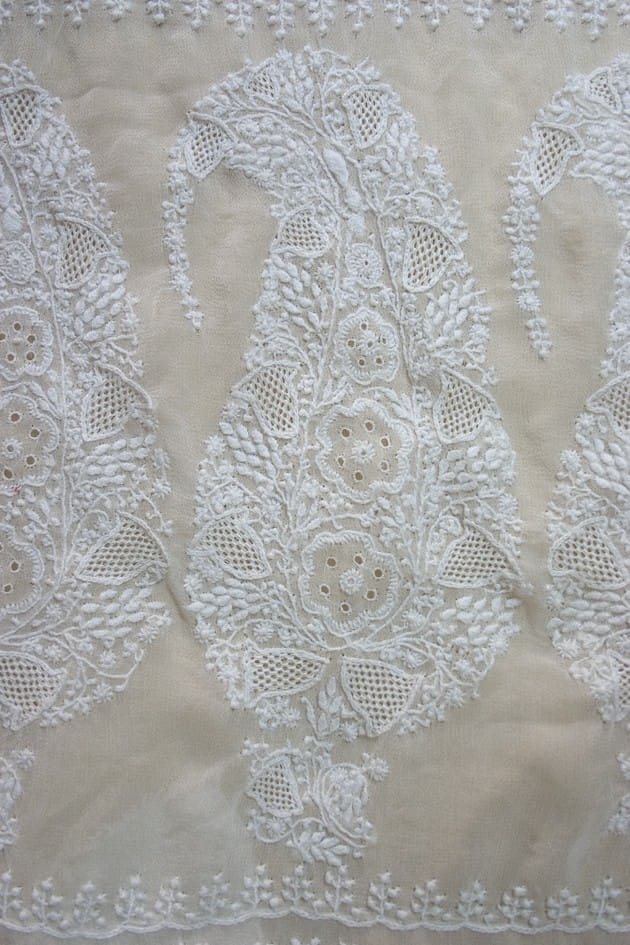
Chikankari knotted, embossed stitches with their traditional names are:
1. Murri: It is the diagonal satin stitches worked several times with a knot on a basic taipchi stitch to form a grain shape.
2. Phanda: It is a smaller shortened form of murri. The knots made are spherical and very small. It resembles millets, gives a raised effect and is used to fill petals and leaves.
3. Dhum patti: It is the leaf pattern made of cross-stitch.
4. Ghas patti: It is the grass leaves formed by V-shaped line of stitches worked in a graduated series on the right side of the fabric.
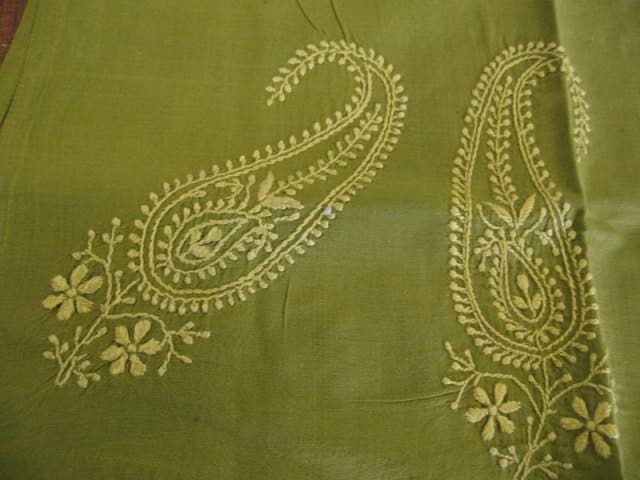
Besides there are two other important forms of embellishments:
1. Jali work: The jaalis or trellises that are created in chikankari are a unique speciality of this craft. It gives an effect of open mesh or net created by carefully pushing warps and wefts apart by needle without cutting or drawing of thread. The act thus make neat regular holes or jaalis on the fabric.
2. Khatawa: It is an appliqué work similar to bakhia, which produces a flat effect. It is more of a technique than a stitch.
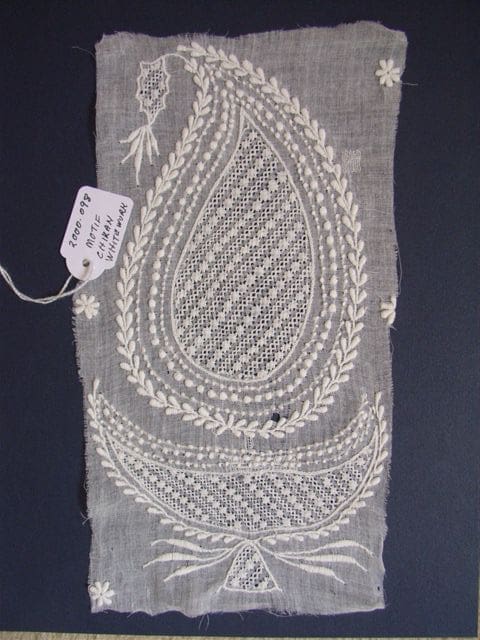
Motifs
The source of most of the design motifs in chikankari is Mughal. Noor Jehan’s personal preferences and desire to replicate the Turkish architectural open-work designs is said to have that led to the introduction of jaalis in chikan embroidery. The designs in chikan are graded and used according to the stitches employed – murri ka buta and tepchi ka jaal – though terms like hathi (elephant) and kairi (mango) are also used to signify the shape of the motif. It is however the stitch employed that is the established nomenclature. Other common motifs include mostly paisley, flowers, foliages, creepers, fruits, birds like peacock and parrots.

Typical White on White Chikankari

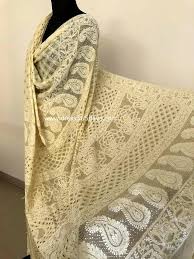

The Luxury of Banarasi Brocade
Banarasi brocades are one of the finest fabrics that India has to offer. It is a specialty of Varanasi, formerly known as Banaras, from which the fabric derives its name. Throughout history, brocade was a fabric of luxury worn by nobility in various cultures, from India to Korea. Brocade is a heavy fabric similar to jacquard with a raised pattern or floral design. Traditionally the pattern was produced with gold or silver thread said to be of such superb quality that they could be woven into fabric of pure gold and silver. There is evidence of different textured brocades since the Rig Vedic period c. 1750-500 BCE, including fabric of gold known as Hiranya Vastra. Silkora, a mixture of silk and cotton, is a modern textile innovation of Banarasi brocade.
In regular weaving, the weft thread passes over the warp thread. The weft is the transverse thread, and the warp thread extends through the length of the fabric. In brocade weaving, extra weft threads of different coloured silk or metallic threads, better known as zari, are woven into the base fabric to form a pattern. The use of zari is not only traditional in Banarasi brocade, but also in the embroidery art of Zardosi.
The process of weaving with silk in progress Preparation of gold zari threads for the weaving of a brocade saree

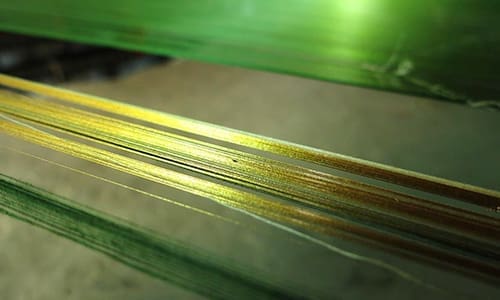
The process of weaving with silk in progress
Preparation of gold zari threads for the weaving of a brocade saree
Banarasi sarees are made in Varanasi, the city formerly known as Banaras. Sarees from Varanasi perfectly combine the finest Indian and
Persian textile designs. The silk weaving industry in Varanasi is steeped in centuries of tradition and its hallmark is the Banarasi brocade saree. Designs are so intricate that to weave one such saree it can take anywhere between 14 days to six months to complete. For this reason, they are recognised throughout India as a sign of opulence and elegance.
A variety of patterns commonly found on Banarasi sarees Close-up of a Banarasi brocade saree
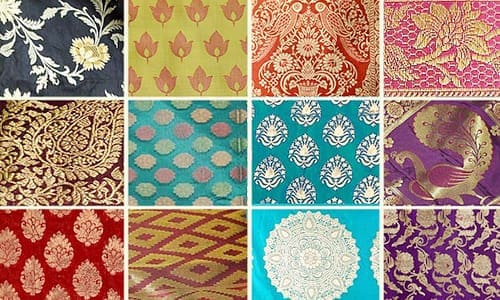
A variety of patterns commonly found on Banarasi saree

Close-up of a Banarasi brocade saree
Today, as it was traditionally, weaving of the sarees is done at home for as many as 1,200,000 people, all of whom have come from a lineage of association with the handloom silk industry in and around Varanasi. The Geographic Indication (GI) status given to Banarasi brocade means that brocade sarees made only in the districts of Varanasi, Chandauli, Mirzapur, Jaunpur, Bhadohi and Azamgarh in Uttar Pradesh can be authentically identified as Banarasi saree or brocade. Banarasi sarees are often the saree of choice for women attending important events and are routinely included in a bride’s trousseau. Banarasi sarees are even regarded as heirlooms, being passed down from one generation to the next. The four main fabric varieties of Banarasi sarees are: pure silk katan, organza with zari and silk kora, georgette, a sheer lightweight crêpe fabric, and shattir, used in modernised Banarasi sarees.
ZARDOSI
Zardosi, the dressing for the privileged, is an ancient skill where gold and silver threads are used to create elaborate embroidered garments. The word ‘Zardosi’ stems from two Persian words – ‘zar’ meaning ‘gold’ and ‘dosi’ meaning ‘embroidery’. It is prevalent in countries like India, Iran, Pakistan and Bangladesh.
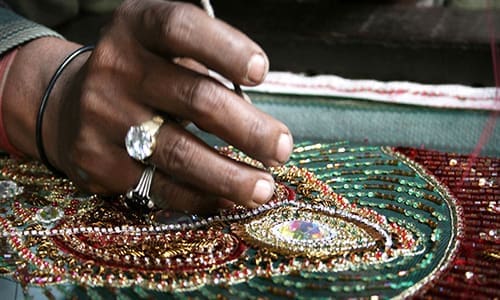
Finishing touches are applied to Zardosi embroidery
The technique entered India with Persian invaders, and reached its apex during the reign of the Mughal emperor Akbar. He was so fond of this flamboyant embroidery technique that the royal garments of his court and courtesans, the courtroom decorations and the tent walls, all incorporated Zardosi embroidery in some way. Some references illustrate the presence of this technique during the Rig Vedic period, where zari was believed to adorn the attire of the Gods.
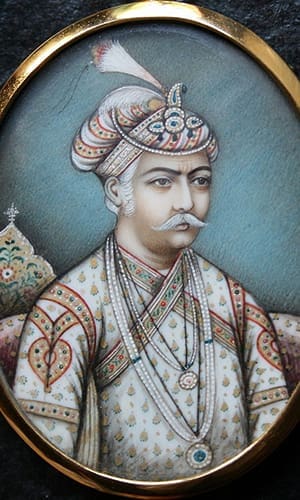
Emperor Akbar in Zardosi garment
Elaborate Zardosi patterns in gold and silver can be enhanced by the use of seed pearl studs and precious stones on exquisite materials like velvet and silk. The final garment, along with the embroidery, is not only beautiful but also very durable, fit to be passed down as an heirloom.

Elaborate elegant Zardosi embroidery
A decline in the production of Zardosi work has been prominent, since the cost involved in producing it is considerably high, and the materials required are beyond the reach of craftsmen. Needless to say, these garments are out of reach for most people. This problem has been overcome to a large extent by substituting the hugely expensive gold wire with copper wire or silk threads covered in gold. This not only reduces the cost incurred without drastically altering the overall look, but also tremendously lowers the price for the customers, thereby expanding the clientele base. Today, Zardosi is incorporated in the embellishment of several materials like wood, handmade paper and fabric to make fine pieces of art and displays of incredible skill.

A Zardosi craftsman at work

One of many Zardosi patterns

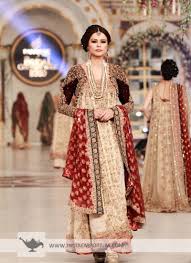
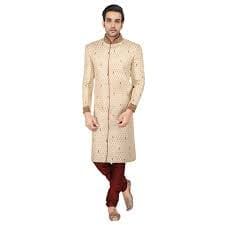
Arts and Crafts in Uttar Pradesh
Vivid and ancient like the land, arts and crafts in Uttar Pradesh are timeless treasure. Discover the mysteries as you explore the legacy that state has produced. Dating back to the pre-historic era, the artistic creations are a part of the history, culture and tourist experiences. The plethora of art, crafts, carvings, sculptures, performances, traditions and many masterpieces handcrafted by the skilled artisans of the trade add to the fascinating range of arts and crafts.
Here are some of the important arts and crafts in Uttar Pradesh
Stone Craft

When it comes to the marvelous arts and crafts, the Stone Craft of Uttar Pradesh deserves a mention. These skills date long back in the days of the yore, while it flourished abundantly especially under the rule of Mughals especially. The most magnificent example of craftsmanship in stone is the Taj Mahal. The white-marble mausoleum is breathtaking, one of the wonders of the world and A UNESCO World Heritage Site.
Elaborate carvings, sculptures, decorative times and various other tokens serve as the most popular creations. The must-visit places to marvel at the artistry include Agra, Varanasi and Fatehpur Sikri.
Pottery
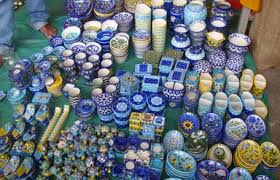
The finesse of pottery creations of Uttar Pradesh is a legend. The history of artistry dates almost 600 years back. In the state, Meerut, Khurja and Hapur are the places which have earned repute with their skills. Though handmade the pots come e embellished with beautiful floral designs and patterns in vibrant colors.
A unique creation of pottery is Surahi, a vessel with long neck. They are used in summers to keep the water cool while also looking great as a decoration. Clay and Terracotta Sculptures are also the hand-made masterworks that look attractive and are integrated into the very fabric of the culture of Uttar Pradesh.
Music

Artistic musical performances are also a part of the arts and crafts that have originated in Uttar Pradesh. The oldest city of the civilization, Varanasi is known for the ancient music traditions. The style of singing, the use of music instruments and the ragas and tales are unique. Interestingly, Varanasi is listed among the UNESCO “Cities of Music” under the Creative Cities Network. There are dedicated music festivals held along the banks of River Ganga that celebrate the ancient traditions.
Performances
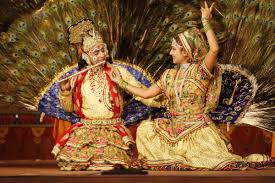
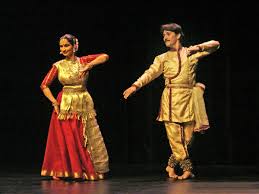
Preforming arts are a part of Indian culture as it is in Uttar Pradesh. Nautanki, Khayal, Ramlila and Raslila are some popular names. Each with roots in ancient history have evolved over the centuries. While some narrate the tales of Indian mythology, some share roots with foreign traditions, especially Persia.
The traditional dresses for the people of Uttar Pradesh are guided by the geographical considerations just like any other area. Uttar Pradesh is a vast state with an enormous diversity in its region, arts, people and culture. As far as the clothing style of Uttar Pradesh is concerned, people prefer the cotton fabric more as it is not only comfortably wearable but also suits the climatic conditions of the area. The clothing style of state is fairly inclined more towards the national side than something of the western influence. It has a blend of both the Hindu and Muslim religions.
Traditional Dresses of Women in Uttar Pradesh


The appropriate garment for the women includes a blouse and a saree draped in a way covering the abdomen area. The saree is supported using a basic garment know as petticoat worn inside. Another garment is the lehenga choli which is worn both daily and occasionally depending on the women. The lehenga or Ghagra choli is worn with a vein or œodhni in a pattern which is similar to wearing a saree. They also wear Salwaar Kameez but mostly sarees are worn by majority of the women.
There are two types of sarees, one is of a standard length of 5.5 yards and the other is of a shorter length. The later one has a resemblance with œodhni . However, most of the cotton sarees available in the state have a chikankari thread work over them which is a famous embellishment of Lucknow. Brocade+- is another famous silk work done over Benarasi sarees which are worn during the wedding and kept as an asset. The fabrics use metallic work or silver and gold all over the saree.
Traditional Dresses of Men in Uttar Pradesh


The men are mostly found wearing a cotton kurta with a cotton dhoti on a daily basis. They wear topi or more appropriately known aspagdi their head which is a made by tying knots with a cotton fabric especially of solid colours like blue, pink, orange, etc. On occasions, they wear sherwanis with a churidar. The sherwanis are similar to the brocade sarees of women as they have high embellishment of silver or gold thread work. It is silk fabric or crepe fabrics used for the churidars worn under the sherwani. They wear a pagdi made up of crepe or any high quality fabric for such occasions which is different from the daily wears.
However, with the changing winds of civilization and exposure to globalization, western outfits are being worn and accepted by the people too. They especially belong from a middle class or high class status. It has gained popularity among the present generation.
Accessories
The bride in an Uttar Pradesh wedding decorates her outfit with a great deal of overwhelming adornments from head to toe, which is for the most part made of Gold. The essential ornaments, for example, necklaces, bangles, nath, earrings and anklets are a piece of each wedding outfit.
• Nathni

This marriage nose ring is adorned with hued stones. Embellished with two pearls and a pendulous globule, the Nathni arrives in an assortment of shapes, shades and sizes.
• Benda

It is worn along the central parting of the hair, the Benda drops down work the forehead. The ornament has two chains which are tied along the hairline heightening the charm of the bride.
• Sita Rani

A novel necklace set with elegant long pendant design. Shaded stones improve the magnificence of this well known necklace which comes in intricate designs and mesmerizing styles.
• Haathphool
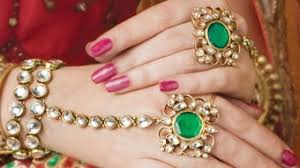
Actually meaning “hand bloom”, this is a combination of a ring and an arm jewelery. A blossom molded center segment that sits on the core of the palm is linked to the wristband and to one or more rings. Down hundreds of years this ornament has been worn by North Indian brides.
• Ancia Kangan
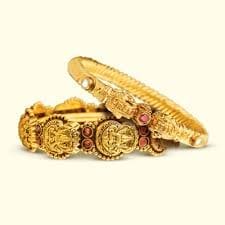
Traditionally designed and handmade to flawlessness, Ancia Kangan is adorned with beautiful stones and Meenakari work, inserted for a restrictive look. These bangles match with different sorts of dresses and could be worn on any part or ceremony included in the wedding
TRIBES OF UTTAR PRADESH


One of the most populated states in India and is also home to many tribal communities. Some of the main tribes in the state are Baiga, Agariya, Buksha, Kol and more and some of them have been recognized as the Scheduled Tribes by the Government of India. The tribal population of Uttar Pradesh mostly hails from the hilly regions of Uttar Pradesh and is also one of the weakest communities in the entire state.
Agariya Tribe of Uttar Pradesh: One of the Scheduled Tribes of Uttar Pradesh is the Agariya people. During the years of the British rule, the ones who lived in and around Mirzapur were involved in the mining of iron.
Aheria Tribe of Uttar Pradesh: An ethnic community of people in India, Aheria is mainly found in the state of Uttar Pradesh and Rajasthan. Before the 1920s, they were mainly hunters but later on they became farmers.

Baiga Tribe of Uttar Pradesh: Commonly found in Uttar Pradesh, Jharkhand, Madhya Pradesh and Chhattisgarh, the Baiga tribe also has some sub castes like Nahar, Bijhwar, Narotia, Kadh Bhaina, Rai Bhaina, Bharotia etc.
GANGA AARATI
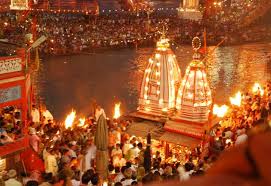
The “AARATI”, is normally sung at the conclusion of any religious ceremony or puja, or simply by itself each morning and evening as a joyous celebration to the Supreme within us and without. The lighting of the lamps for the Aarati, has a manifold significance. On the one hand it denotes the light of spiritual knowledge, the illumination of truth. On the other hand, when camphor is used as the fuel to light up the lamps, the camphor eventually burns out and disappears without a trace. This signifies the total destruction of the ego in the light of true knowledge or – the illumination of the self in union with the Universe.
The Ganga Aarati at Rishikesh is an unforgettably spiritual experience. Performed each evening at sundown at the Parmarth Niketan Ashram, on the banks of the holy river Ganga, it is an event to gladden the heart, feed the soul and create harmony with the elements. Fire, Water, Earth, Air combine in perfect synergy during this ritual and leave you with a feeling of having witnessed perfection.
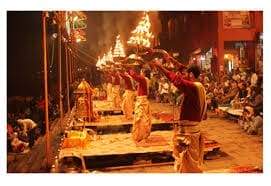
The one and half hour ceremony, starting with sacred chants and a ‘Yagna’ or fire ceremony, during which a mixture of sacred herbs and ghee (clarified butter) are poured into the fire in order to dispel negative energies, is concluded with the Aarati, during which the river is worshipped as the source of life on the physical plane, and as a symbol of the eternal life circle on the metaphysical plane.
The performance of the Aarati by the Guru, the singing of bhajans (hymns) by the saffron robed disciples, the fragrance of incense and camphor as it permeates the air, the mesmeric light of myriad diyas, the sound of the rushing river, the setting sun mirrored in sparkling ripples on the flowing water, the intensity of the people as they sway in unison, all combine to create a surreal atmosphere of peace that pervades every sense and remains with you long after you have left Rishikesh.
TOURISM IN UTTAR PRADESH
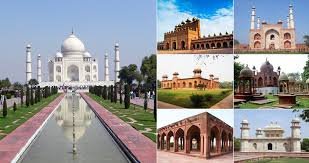
Embedded in the heart of India is Uttar Pradesh, a land where cultures have evolved and religions emerge. The greatness of Uttar Pradesh lies not only in this confluence, but also in the emergence of cultural and religious traditions along some of the greatest rivers in the Indian sub-continent – the Ganga and the Yamuna.Throughout history, great cities have emerged and established along great rivers. Within India, the Ganga and the Yamuna have nurtured a culture because of which religious faith, rituals, culture and intellectual enlightenment have evolved in places along the two rivers.
Official tourism website- https://www.uptourism.gov.in/
Article written by bhavika gulrajani B.Sc in Textile and Apparel Designing from Sir Vithaldas Thackersey College of Home Science. Textile Value Chain intern.

